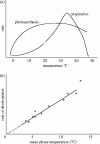Crop responses to climatic variation
- PMID: 16433091
- PMCID: PMC1569569
- DOI: 10.1098/rstb.2005.1752
Crop responses to climatic variation
Abstract
The yield and quality of food crops is central to the well being of humans and is directly affected by climate and weather. Initial studies of climate change on crops focussed on effects of increased carbon dioxide (CO2) level and/or global mean temperature and/or rainfall and nutrition on crop production. However, crops can respond nonlinearly to changes in their growing conditions, exhibit threshold responses and are subject to combinations of stress factors that affect their growth, development and yield. Thus, climate variability and changes in the frequency of extreme events are important for yield, its stability and quality. In this context, threshold temperatures for crop processes are found not to differ greatly for different crops and are important to define for the major food crops, to assist climate modellers predict the occurrence of crop critical temperatures and their temporal resolution. This paper demonstrates the impacts of climate variability for crop production in a number of crops. Increasing temperature and precipitation variability increases the risks to yield, as shown via computer simulation and experimental studies. The issue of food quality has not been given sufficient importance when assessing the impact of climate change for food and this is addressed. Using simulation models of wheat, the concentration of grain protein is shown to respond to changes in the mean and variability of temperature and precipitation events. The paper concludes with discussion of adaptation possibilities for crops in response to drought and argues that characters that enable better exploration of the soil and slower leaf canopy expansion could lead to crop higher transpiration efficiency.
Figures















References
-
- Adams R.M, Rosenzweig C, Pearl R.M, Ritchie J.T, McCarl B.A, Glyer J.D, Curry R.B, Jones J.W, Boote K.J, Allen L.H., Jr Global climate change and US agriculture. Nature. 1990;345:219–224. doi:10.1038/345219a0 - DOI
-
- Al Khatib K, Paulsen G.M. High temperature effects on photosynthetic processes in temperate and tropical cereals. Crop Sci. 1999;39:119–125.
-
- Amthor J.S. Respiration in a future, higher-CO2 world. Plant Cell Environ. 1991;14:13–20.
-
- Bolanos J, Edmeades G.O, Martinez L. Eight cycles of selection for drought tolerance in lowland tropical maize: III. Responses to drought-adaptive physiological and morphological traits. Field Crop Res. 1993;31:269–286.
-
- Bowes G. Growth at elevated CO2: photosynthetic responses mediated through Rubisco. Plant Cell Environ. 1991;14:795–806.
Publication types
MeSH terms
Grants and funding
LinkOut - more resources
Full Text Sources
